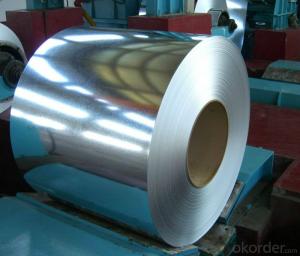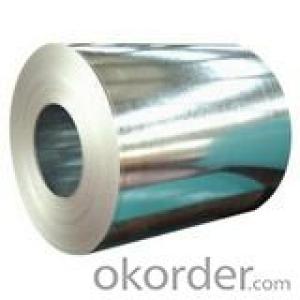Galvanized Steel Sheet in Ciols with Prime Quality
- Loading Port:
- Shanghai
- Payment Terms:
- TT OR LC
- Min Order Qty:
- 50 m.t.
- Supply Capability:
- 1000 m.t./month
OKorder Service Pledge
OKorder Financial Service
You Might Also Like
1.Structure of Galvanized Steel Coil Description:
Hot-dip galvanized steel coils are available with a pure zinc coating through the hot-dip galvanizing process. It offers the economy, strength and formability of steel combined with the corrosion resistance of zinc. The hot-dip process is the process by which steel gets coated in layers of zinc to protect against rust. It is especially useful for countless outdoor and industrial applications.
2.Main Features of the Galvanized Steel Coil:
• Base material for countless outdoor and industrial applications
• High corrosion resistance
• High strength
• Good formability
• Rust- proof ability
• Good visual effect
3.Galvanized Steel Coil Images

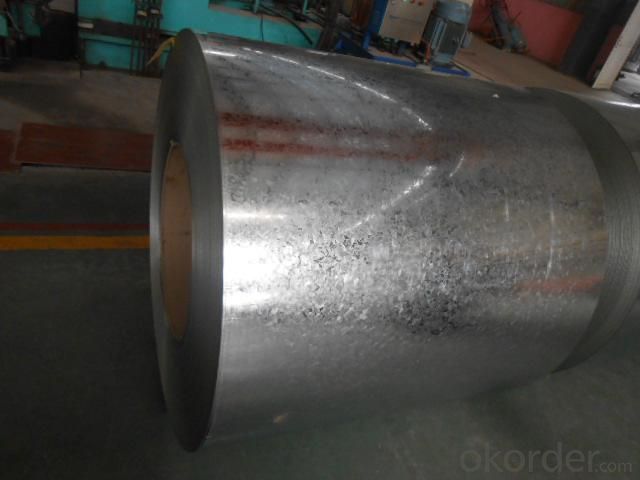
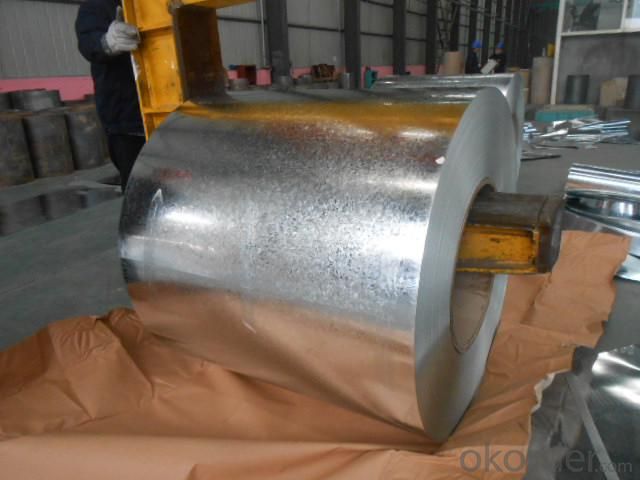
4.Galvanized Steel Coil Specification
Operate Standard: ASTM A653M-04/JIS G3302/DIN EN10143/GBT 2518-2008
Grade : SGCD,SGCH, Q195,DX51D
Zinc coating :40-180g( as required)
Width:914-1250mm(914mm, 1215mm,1250mm,1000mm the most common)
Coil id:508mm/610mm
Coil weight: 4-10 MT(as required)
Surface: regular/mini/zero spangle, chromated, skin pass, dry etc.

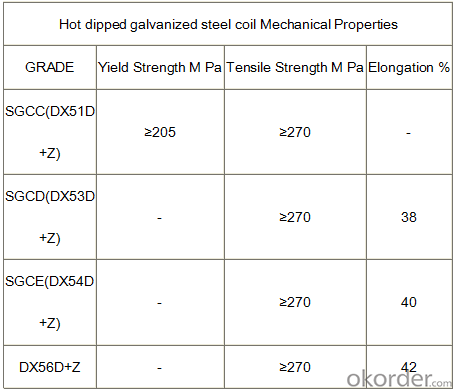
5.FAQ of Galvanized Steel Coil
We have organized several common questions for our clients,may help you sincerely:
1.How to guarantee the quality of the products?
We have established the international advanced quality management system,every link from raw material to final product we have strict quality test;We resolutely put an end to unqualified products flowing into the market. At the same time, we will provide necessary follow-up service assurance.
2. What is the minimum order quantity ?
Our MOQ is 50mt for each size. And we will consider to give more discount if you make big order like 1000 tons and more. Further more, the more appropriate payment term your offer the better price we can provide.
3.How long can we receive the product after purchase?
Usually within thirty working days after receiving buyer’s advance payment or LC. We will arrange the factory manufacturing as soon as possible. The cargo readiness usually takes 15-25 days, but the shipment will depend on the vessel situation.
- Q:Are they made using the same processes, or is tempered steel made without the quenching process?
- No. Not quite. The term 'Hardened steel' is often used to refer to 'Heat treated steel'. There are two separate steps in heat treatment. First the red hot steel is 'quenched' (rapidly cooled). This yields maximum hardness ,but the steel may be too brittle for the intended purpose. The next stage, 'tempering' is heating to a limited temperature, and slow cooling. This reduces the hardness somewhat, depending on the re-heat temperature, but restores some of the toughness lost in the first stage.
- Q:How are steel coils used in the production of automotive components?
- Steel coils are used in the production of automotive components as they are a primary raw material for manufacturing various parts like chassis, body panels, suspension systems, and engine components. These coils are processed and shaped using various techniques such as cutting, bending, stamping, and welding to create the required components, ensuring strength, durability, and precision in the final product.
- Q:How are steel coils used in the manufacturing of food packaging?
- Steel coils are commonly used in the manufacturing of food packaging to create various types of containers such as cans and tins. These coils are formed into the desired shape and then coated with a food-grade lacquer to ensure the safety and preservation of the packaged food. The strength and durability of steel make it an ideal material for protecting and storing food products, allowing them to be transported and stored without compromising their quality.
- Q:How are steel coils used in the production of steel pipes?
- Steel pipes rely on steel coils as a vital element in their production. These coils serve as the primary material for manufacturing the pipes. The initial phase of the process involves unwinding the steel coil and introducing it into a machine referred to as a slitter. The slitter then cuts the coil into narrower strips of the desired width. This width plays a crucial role as it determines the diameter of the resulting steel pipes. Once the steel coil has been sliced into strips, the subsequent step is to feed these strips into another machine known as a forming mill. The forming mill gradually shapes the strips into a cylindrical form by passing them through a sequence of rollers. These rollers apply pressure and bend the strips until they assume the shape of a pipe. To ensure the pipes' durability and strength, they undergo a welding procedure. The ends of the strip are heated and fused together using a high-frequency electric current, creating a seamless weld along the entire length of the pipe. This weld provides structural integrity and prevents any leakage or weak points in the pipe. After the welding process, the pipes undergo a sizing and shaping procedure. They are passed through additional rollers, gradually reshaping them to achieve the desired dimensions, including the final outer diameter and wall thickness. Finally, the pipes are cut to the desired length and undergo various finishing procedures, such as straightening, testing, and coating. These finishing steps guarantee that the pipes meet the required specifications and are ready for use in various applications, such as plumbing, construction, and the oil and gas industries. In conclusion, steel coils serve as the foundation for the production of steel pipes. They are slit, formed, welded, sized, shaped, and finished to create robust and high-quality pipes suitable for diverse industries.
- Q:What are the dimensions of steel coils used in the power generation industry?
- The dimensions of steel coils used in the power generation industry vary depending on the specific application and requirements. However, common dimensions for steel coils used in this industry are typically in the range of 0.5 to 3.0 millimeters in thickness and 600 to 2000 millimeters in width. The length of the coil can vary, but it is often in the range of several hundred to several thousand meters.
- Q:What is the maximum diameter of a steel coil?
- The maximum diameter of a steel coil can vary depending on the specific manufacturing process and equipment used. However, in general, the maximum diameter of a steel coil can range from a few inches to several feet.
- Q:What is the standard thickness of steel coils?
- The standard thickness of steel coils can vary depending on the specific application and industry. However, common thickness ranges for steel coils typically fall between 0.015 inches (0.38 mm) and 0.125 inches (3.17 mm).
- Q:How are steel coils used in the manufacturing of household appliances?
- Steel coils are used in the manufacturing of household appliances as a raw material for forming various components such as panels, frames, and structures. The coils are typically cut, shaped, and welded to create the necessary parts used in appliances like refrigerators, stoves, and washing machines. The durability and strength of steel make it an ideal material for ensuring the longevity and performance of these appliances.
- Q:I want an EDC (Every Day Carry) Knife that:~folds~is non-serrated~has a pocket clip~has a blade length of about 4 in. long~is concealable~urban environment friendly~priced around $50What do you suggest? I am currently thinking on purchasing the Cold Steel 4 inch Zytel Ti-Lite.
- Based okorder /
- Q:How are steel coils heat treated?
- Annealing is the method used to heat treat steel coils, resulting in improved mechanical properties and overall performance. To achieve this, the coils are heated to a specific temperature and slowly cooled down. This process relieves internal stresses within the steel and enhances its performance. To begin the heating process, the steel coils are raised to a critical temperature, typically between 800°C and 900°C, depending on the desired outcome. They are then maintained at this temperature for a specific period of time, allowing for the transformation of the steel's microstructure. Once the desired time has passed, the heated coils are carefully cooled down in a controlled manner. This gradual cooling process is crucial as it allows for a uniform and refined microstructure. It also helps prevent the formation of internal stresses that could weaken the steel. The annealing process can be conducted in various atmospheres, such as air, nitrogen, or hydrogen. The choice of atmosphere depends on the specific requirements and properties desired for the steel coils. For example, annealing in a protective atmosphere like nitrogen or hydrogen can prevent oxidation or decarburization of the steel surface. In conclusion, annealing is a crucial step in heat treating steel coils, resulting in improved mechanical properties, enhanced formability, and the desired characteristics for industrial applications.
1. Manufacturer Overview |
|
|---|---|
| Location | |
| Year Established | |
| Annual Output Value | |
| Main Markets | |
| Company Certifications | |
2. Manufacturer Certificates |
|
|---|---|
| a) Certification Name | |
| Range | |
| Reference | |
| Validity Period | |
3. Manufacturer Capability |
|
|---|---|
| a)Trade Capacity | |
| Nearest Port | |
| Export Percentage | |
| No.of Employees in Trade Department | |
| Language Spoken: | |
| b)Factory Information | |
| Factory Size: | |
| No. of Production Lines | |
| Contract Manufacturing | |
| Product Price Range | |
Send your message to us
Galvanized Steel Sheet in Ciols with Prime Quality
- Loading Port:
- Shanghai
- Payment Terms:
- TT OR LC
- Min Order Qty:
- 50 m.t.
- Supply Capability:
- 1000 m.t./month
OKorder Service Pledge
OKorder Financial Service
Similar products
New products
Hot products
Related keywords
